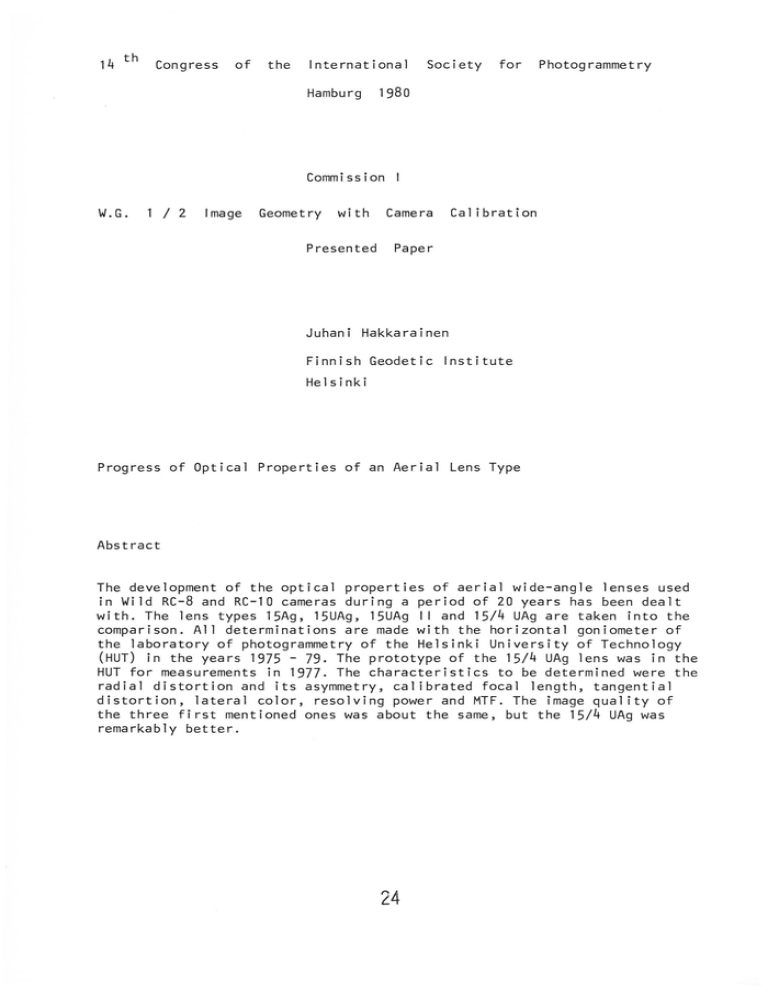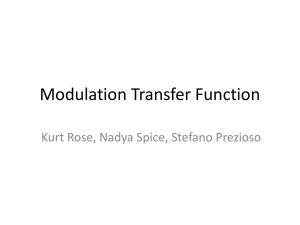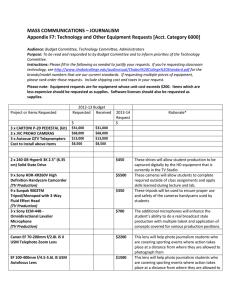I
advertisement

14 th
Congress
of
the
International
Hamburg
Society
for
Photogrammetry
1980
Commission I
W.G.
1 I 2
Image
Geometry
with
Presented
Camera
Calibration
Paper
Juhani Hakkarainen
Finnish Geodetic Institute
Helsinki
Progress of Optical Properties of an Aerial Lens Type
Abstract
The development of the optical properties of aerial wide-angle lenses used
in Wild RC-8 and RC-10 cameras during a period of 20 years has been dealt
with. The lens types 15Ag, 15UAg, 15UAg I I and 15/4 UAg are taken into the
comparison. All determinations are made with the horizontal goniometer of
the laboratory of photogrammetry of the Helsinki University of Technology
(HUT) in the years 1975 - 79. The prototype of the 15/4 UAg lens was in the
HUT for measurements in 1977. The characteristics to be determined were the
radial distortion and its asymmetry, calibrated focal length, tangential
distortion, lateral color, resolving power and MTF. The image quality of
the three first mentioned ones was about the same, but the 15/4 UAg was
remarkably better.
24
Introduction
In the period 1969-74 a horizontal goniometer for the calibration of aerial
cameras was developed in the HUT. All aerial cameras used in Finland have
been tested with this equipment with intervals of 1-3 years. The characteristics to be determined are: Radial distortion and its asymmetry , calibrated
focal length, main component of tangential distortion, lateral color, resolving power and MTF .
The study relates to the lens series for RC-8 and RC-10 wide-angle cameras.
The lenses are:
First calibration by Wild
1 ) 15Ag
No . 102
1960
2) 15UAg
No . 246
1964
3) 15UAg II No.3014
1973
4) 15UAg II No.3058
1975
5) 15/4UAg No. 13001
1977 (prototype)
The whole calibration program was performed for the lenses 15UAg No . 246 and
15UAg II No . 3014 in 1975. The 15UAg II No . 3058 lens was measured in 1977 .
Wild Heerbrugg delivered the prototype of the new type 15/4UAg to the HUT
for comparison measurements in the same year. the author made the determinations for this lens in October-November 1977. The 15Ag No. 102 has been
measured several times, last time in 1979.
Radial and tangential d i stortion
In the determination of the radial distortion in princ i ple the same method
is used as that used by Wild Heerbrugg and Carl Zeiss Oberkochen . The observations are made from both sides of the goniometer two times . The origin
of the measurement is the principal point of autocollimation. Twenty points
~n one semidiagonal are measured. The standard error of the distortion is
-2 )Jm.
The symmetrical component of tangential distortion is determined by measuring the bending of a horizontal straight (diameter)! ine of the grid . The
bending is caused by the aerial lens. The systematic errors caused by the
goniometer are eliminated wholly. The standard error of the tangential distortion determined by this method is +- 1 )J m.
The geometrical errors of the lensser i es stud i ed are presented in the figures 1 and 2. The radial distortion of the cameras 1-4 is notified only to
the value r = 100 mm, because in the corner area of the image the phase
shift phenomen causes remarkable lack of clearness in the image of the grid
crosses in the calibration when the 1 i nes are i n diagonal direction as the
situation is in the goniometer of the HUT . Th i s lack of clearness does not
appear in the 15/4UAg lens .
Al 1 propert i es 1 i sted in the i ntroduction are almost characterist i c to the
lens type , except the components of decentering distortion, the asymmetry
of the radial distortion and the tangential distortion which are in pr inciple i ndiv i dual . The symmetry of newer lenses of Wil d (after 1968) has ,
however, been excel lent in al 1 five lenses measured in the HUT , the maximum
value of tangential distortion being ~ 1 lJ m.
25
Calibrated focal length
Wi l d
Lens
15Ag
15UAg
15UAg II
15UAg I I
15/4 UAg
No . 102
No . 246
No.3014
No . 3058
No. 13001
HUT
153.34
1 52. 1 4
153 . 07
153. 13
153.24
1979
1972
1975
1976
1977
153 . 35
1 52 . 1 4
153.06
153.13
153.24
(.347)
(.137)
(.062)
( . 1 32)
(. 244)
1979
1974
1975
1977
1977
The variations in the spectral distributions of 1 ight and in the temperatures may be reasons for the differencies. The standard error of determination of the cfl generally seems to be~ 0.01 mm by visual goniometers .
There are 6 cameras calibrated by Wild Heerbrugg, 5 cameras calibrated by
Carl Zeiss Oberkochen and these 11 cameras calibrated in the HUT in the
sample.
Lateral color
The lateral color was determined by using a continuous interference filter
behind the eyepiece of the observing telescope in the goniometer. The radial distortion was determined with 9 wave lengths of 1 ight from 450 nm to
650 nm. The results are in the fig . 3 .
Resolving power
The RP of the lens cone was determined without the influence of film. In
this method the camera is in the horizontal position in the goniometer . The
test plate with 9 groups of test figures at field angles from 0° to 43° is
placed onto the camera frame. The figures can be observed with different
filters visually through the lens or they can be photographed through the
observation telescope and the camera with an enlargement of about lOx . The
register camera is Nikon F 1.4/ 50 mm, the film Kodak Panatomic-X, the developer D-76 undiluted. The determination of the resolving power is made
from the prints made from the register negatives. In this manner it is
possible to compare the resolving powers of different cameras better than
by microscope observing. In the four first mentioned lenses there appears
rather strong phase shift and spurious resolution in the corner of the image even at relatively low frequencies. In the 15/4 UAg lens the spurious
resolution begins at so high a frequency that it does not have detrimental
effect either on aerial photograph or on geometrical calibration any more.
The results are in the figure 4 . In the figures we can see that in newer
cameras an attempt has been made by focusing to achieve the optimum quality
for the whole image.
MTF
The films exposed for the determination of the RP are used also for determining the MTF. The main steps of the MTF method are the following :
1. Goniometer photography
2. Measurement of the negatives with a microdensitometer
3. Sens i tometric exposure of the register film. The characteristic curve
constructed in non-logarithmic form
26
4. Transformation of the microdensitometer values into effective exposure
values by using the characterist i c curve.
5. Calculation of the square wave modulation.
6. Square wave modulation to sine wave modulation with Fourier analysis.
7. Corrections caused by the microdensitometer sl i t (modulation 98-99.5%)
and the object figures (modulation 96-98%) .
8. MTF of the Panatomic-X and the adjacency effect influence in the opposite
directions. The errors caused by them and the influence of the goniometer
optics remain as error factors of the method .
The accuracy of the MTF-method used was studied by making the determinations for the camera 15Ag No.102 in 7 field angles in the PTB in Braunschweig, FRG, and in the HUT. The difference of the MTF values determined
by the two methods was mainly from 3 to 10% depending somewhat on the
field angle. In general the method used in the HUT gives a little greater
values than the EROS method used in the PTB. The results of lens series are
in the figures 5.
Conclusion
In the 15UAg I I lens the radial distortion is already! 2 ~m except in the
corner of the picture . In the 15/4 UAg type it has further been a 1 ittle
smaller. It seems that the centering of the lens elements of the modern
cameras is more succesful than that of the older cameras. (The sample is
about 20 cameras measured in the HUT . ) From the 15Ag to 15UAg I I the lateral color has remarkably reducedbutfrom that on it has not changed substantially. In the types 15Ag, 15UAg and 15UAg I I the resolving power and MTF
are practically on the same level. In all three phase shift phenomena and
spurious resolution appear in the corners of the picture. The RP of the
15/4 UAg lens is essentially better in these areas. The 15/4 UAg type has
also a better MTF at greater values of the field angle than the former
types and much better MTF with the aperture of 1:4 than the 15UAg I I type.
Acknowledgements
The author wishes to thank the Institute of Photogrammetry of the Helsinki
University of Technology, where al 1 measurements were possible to do, and
Wild Heerbrugg, who sent the 15/4 UAg prototype to the HUT in the year 1977
for comparison research.
References
Hakkara i nen, J.
On the Use of the Horizontal Goniometer in the
Determination of the Distortion and Image
Quality of Aerial Wide-Angle Cameras. 163 p.,
Helsinki 1976
Wild Heerbrugg
Calibration Certificates of the RC-8 15Ag
No.102, RC-8 15UAg No.246, RC-10 15UAg I I No .
3014, RC-10 15UAg I I No.3058 and measurements
of the 15/4 UAg No.13001.
27
•[]'
D
.J.1
(111111
C
I
f[mm]
1SO
f[mmj
I
I
I
\
/
' ' ,,,' ' '
\
I
1,
\
''
15Ag No. 102
...lr [on1]
.1r jum]
I
f[mm]
I
I
..............!
I
15UAg No. 246
~r
. .\r J.umJ
.umj
I
I
I
I
I
I
I
___ /
r [mm]
15UAg II No. 3058
i5UAg II No . 3014 is similar )
.1 r [1•m]
V::::5<'007\__
:!--?""'
'
"
"-"
~-- '"
-·
_,
f [mmJ
15 I 4 UAg No.
Four s emi d i agona l s ,
f[mm]
1 30 0 1
Mean radial
--- ---- HUT
o ri g in at PPA
Fi g . 1.
Radial distort i on .
28
distortion
- -- --
Wi 1d
0
"
""
0
0
..._
.--
""
~'
""
/
0
0
0
__.
/
-......
'\.
I
\
\
<:s
\
I
--...£· ~'!_--
"
"
\
""
........__
\
'+
........__
0
0
..__
""
..1
--- -I
'
""
'" '
~
'
+---
'\.
....
o---r-: .....
MAX =.c 111 m
MA X
0
15Ag No. 102
/
/'
2 Bt<m
15UAg No . 246
+
MAX =0
MAX
111"~
15UAg I I No . 3058
15/4 UAg No . 13001
( 15 UAg I I No . 3 0 14 i s simi 1a r
Fig . 2 .
~1
Mai n component of tangential d i stortion .
29
0 II"'
ll(il r)
..
r
ll :il r1
[mm]
..
[ ,umJ
[ ,J.Lm)
\
r
[mm]
120
..
""
,.
112
\
'
20
10
i
~
.\ [nm]
.{ [ nm]
15UAg No . 246
15Ag No . 102
r
[mm]
il (L\ r )
[ ,J.L m)
20
10
a
i
~l
15UAg I I No .
r
-10
[nm]
i
a
.\ [nm]
3 0 14
15UAg II No. 3058
[mm]
,.
20
10
Fig . 3 .
15I 4 UAg No . 13 0 0 1
30
Latera l co l or .
1:5.6
RP : L/m m j
'
1! 8
15Ag No.
IJ2
1(\
r
''
''
mm
•. r
15UAg No . 246
102
Fig.
r , m ..,J
15UAg I I No.
mm
3058
31
4.
Res o 1 v i n g power •
1:4
\
\
\
\
\
\
\
\
\
\
---.'
,''
\
,· r
r
m m
1 5 UAg
I I No.
m•n
3014
1:5.6
\
\
\
''
\
\
\
''
\
.. . r
' '- --
r
"""
15/4 UAg No.
Fig . 4.
''
13001
Resolving power .
32
mm ·
MTF(%)
Mlf (% )
li Xl
:.-,
80
mm
\\,~
;, .
;, \
oO
40
0
40
~
80
11 8
~
"
1 41
:\ \
'
', \ ..........
'\ .\
...........
I
A.NGLE:
0.0
14 .7
2 7.8
37. 8
4 2.9
mm
0
40
BO
10 0
141
'
...... ......
"
80
\~t~~
·.. ,\
w
w
<0
1: 5.6
;,,,
',,,
,,
·,,
',"
--~
\
\
\
80
il10
.,
,,
--- ~
A."'C.l t
0.0
7.5
20
60
100
3 3.3
141
4 2 .9
2 1.5
',, \'-",',
'
'· ' ,,
'··->,
........,
............
''.·- - ' ·.......
MTF
•o
lo
[%]
oO
..................
80
LINES
mm
Ll ~f ~
mm
•oo
1110
I~
.....
RADIAL
l,l
1: 5.6
1: 5.6
\\\
"I
......
--......---.-::-_,
.....
"''·
,,
. . . . .......
10
'\\
.
'\-._
\
'..::."~
·-----
\ ,_
'
li NfV mm
15t-\g No . 102
.
"""
. . . . .. ......
' '':..~ ''-...:~.....••.:·~:.:::.:.::
,,,
'\
00
itA DIAL
-~
\
20
oO
' \
.\
0
iliJ
60
80
\_ \ \ ..~,
I
"'
.•.\
""
RADIAl
\
rlllll
" .:'"
liN£ ~
IUO
Mlf (% )
' I
"
\\
20
100
60
0.0
14.7
27. 8
33.3
4 2.9
<0
liNES/"""
ao
TA N ENTI AL
·:,
0
,,
.....
60
40
20
Mlf(%)
ANGLE
40
......
\.
'\---------~ ' ·-... ...... _--
10
100
TANGENTIAL
0
"
\
\
Mlf (%)
II (I
TANG EN TIAl
lt Nf ~/ f'MI
40
oo
15UAg No . 246
Fi g . 5.
MTF .
80
""
\,.:
-'•'
--7'": ·~oO
15UAg II No. 3014
MTF [%)
'"'
MH (•,.,]
MTF
TANGF NTIA l
mm
\~
~\
~. \~
\ \~
\\ \'\
\\ \\'
' \ \'\
,.'
•O
',_
\'\
AN G Lf
0
0.0
20
60
100
141
7.5
21.5
33.3
42.9
IAN GF NTIAL
0
mrn
~~'\
\\.~
AN GlE
0
40
80
118
0.0
14.7
27.8
37.8
141
42.9
-....
.
' ·
mm
0
w
"
"
'. '\,\
,., .......,
TA NG ENT IAL
0
\\
118
2~8
3~8
141
42 ,9
\'>;~~~.::.::'"'"
.........
_
;o
·· ...
lJNf S/ mm
20
40
60
:' U
1\10
MTF [o,]
100
' .,U
1'\
"
''
\
~
'
\\,.
" ,,
w
•O
-l::>-
\
.
10
LINE S/ mm
I :JQ
ti')
60
10
MTF [")
•o
I··~
80
100
) ~{)
~A
RAD IAL
','
•o
"
M
14.7
G
UNES/ mm
MTF [")
AN ,...lf 0
·.·. ' '
'·'
\·. '···.'S:\\
·· ....
'<~~
(%)
···u
1'8
1
DIAL
1:4
1:4
ec
''
,,
---------------\~ ---------=-=------~ -
•O
\,
. . .............
ll"•f \
mm
luC
liNES .
10
•o
60
tiO
mm
IVO
15 I 4 UAg No. 13 0 0 1
15 UAg I I No . 3 014
15UAg II No . 3058 i s about s i mi Jar
Fig . 5.
MTF.
liNE '"
"'
ILJJ
mm




